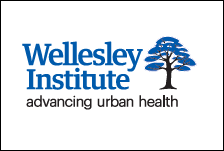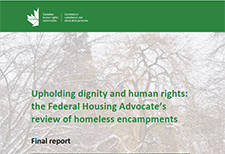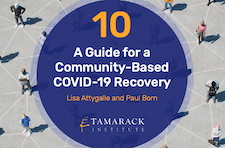Discover financial empowerment resources
Discover financial empowerment resources
Ontario faces three crises in housing – attainability, affordability and homelessness. These crises were and are exacerbated by the ongoing COVID-19 pandemic. The economic chaos created as our American allies become difficult neighbours threatens to pile on top of the COVID-19 damage before our...

The policy brief, Provincial spending on housing and homelessness in Ontario, presents a stark reality: homelessness in Ontario is worsening, with chronic homelessness nearly doubling in just two years. The policy brief finds that: Homelessness is worsening: Over 81,000 Ontarians experienced...

Canada's homeless encampments are a national human rights crisis. A growing number of people in Canada are having to live in tents or informal shelters to survive due to a lack of affordable housing, limited support services, and nowhere safe to go. Recognizing the severity of this crisis, the...

The Municipal Innovation Exchange (MIX) project team created this Toolkit to assist municipalities - individual line managers or project owners, or municipal strategic teams (like a Smart Cities Office) - that are contemplating or undertaking a procurement by means of innovation partnership. The...
Our cities and communities are where people live. It is here we see the effects of public policy and it is here where we will address the issues that matter most to Canadians. The choices made today will impact Canada’s recovery from COVID-19. If we want a future where our cities are thriving, we...

As the connection between financial capability and social mobility is made evident, both public and private actors are increasingly interrogating the drivers of personal financial health and investing in the innovation of products and services designed to improve the condition of economically...

This is a brief on the cost of financially insecure families to Chicago, in terms of cost of eviction and unpaid bills. The financial health of cities depends on financially secure residents. When families have little to no savings and experience a disruption in their income or expenses, bills may...
These are the webinar slides from the Center for Financial Security webinar on the LIFT-UP program approach to municipal financial empowerment with the National League of...
The Consumer Financial Protection Bureau (the CFPB) looked at the information sources consumers are exposed to when they make financial decisions. Empowering consumers to make the financial decisions that will help them meet their own life goals is a critical part of the mission of the CFPB. To...
Local Interventions for Financial Empowerment through Utility Payments initiative (LIFT-UP) was a two-year pilot project conducted by the National League of Cities (NLC) in five cities. LIFT-UP offers city leaders a “win-win” scenario, allowing city utilities to recoup lost revenue due to...
This is the Executive Summary for the LIFT UP model. In 2013, NLC selected five cities to pilot the LIFT-UP model with their city-owned water utilities: Houston, Texas, Louisville, Kentucky, Newark, New Jersey, Savannah, Georgia and St. Petersburg, Florida. Prior to the launch of LIFT-UP, the five...
This is the Final Report for the LIFT UP model. In 2013, NLC selected five cities to pilot the LIFT-UP model with their city-owned water utilities: Houston, Texas, Louisville, Kentucky, Newark, New Jersey, Savannah, Georgia and St. Petersburg, Florida. Prior to the launch of LIFT-UP, the five...
As city-regions across Canada continue to grow, the need for some municipal services, such as mass transit, is shifting from a local to a regional basis. This transformation is giving rise to regional servicing challenges, placing greater pressure on city-regions and their municipalities to provide...
Two years ago, our organizations released The Hidden Epidemic: A Report on Child and Family Poverty in Toronto, which documented the high level of child and family poverty in the City of Toronto and the widespread lack of access by children to decent housing, food, recreation and learning...
Despite progress on many fronts, the number of people becoming homeless in Canadian cities was not declining. As a consequence, there has been a discernable shift in municipal responses to homelessness in recent years. Inspired by policy innovations in the United States, a number of cities are now...
...
TOcore is a three-year inter-divisional initiative, led by City Planning. The purpose of the Study is to ensure growth positively contributes to Toronto’s Downtown as a great place to live, work, learn, play and invest. It will do so by determining: a) how future growth will be accommodated,...
Children need stability to thrive. But across the United States, more and more children are facing the most extreme form of instability and poverty—homelessness. In no place is this more evident than in New York City, where one out of every eight children attending public school in SY...
Approaching anti-poverty work from this view point asks that we re-think the social compact between government and its constituents. It demands that we think beyond reactive policies focused narrowly on crisis intervention and preservation of the safety net, to policies that aim to proactively help...
In 2008, Toronto Public Health released The Unequal City: Income and Health Inequalities in Toronto. The report showed that there were differences in health between income groups in Toronto, that low income groups had worse health for most health status indicators, and that differences in health...
The Unequal City 2015: Income and Health Inequities report provides a summary of the details found in this technical document. These details include: The methodology used to explore current income-related health inequities in Toronto and the change in those inequities over time; The population...
The City of Toronto has been tackling poverty issues for many years. City strategies, programs, and services provide targeted supports to individuals, families, and neighbourhoods. Some of these initiatives are now best practices adopted by other cities. We must continue to do the things that...
This presentation by TESS has two learning outcomes: 1) Define and describe the financial benefits that are available to Ontario Works Participants and 2) Identify the types of employment supports & programs that are available to participants through...
The findings in this report from the National Asset Scorecard for Communities of Color (NASCC) survey reveal major disparities in wealth accumulation across various racial and ethnic groups in Los Angeles. Our analysis shows that with respect to types and size of household assets and debt, there...
The five-year Road Map is a community plan and builds on the EPE Strategy. It is shaped by what we heard from Edmontonians and responds to emerging issues and opportunities in a changing landscape. The Road Map will activate actions towards fulfilling the vision of ending poverty within a...
